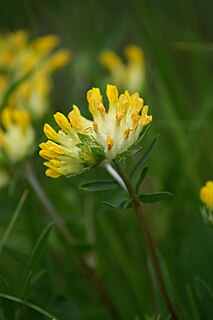Related Research Articles

In soil science, humus denominates the fraction of soil organic matter that is amorphous and without the "cellular cake structure characteristic of plants, micro-organisms or animals". Humus significantly affects the bulk density of soil and contributes to its retention of moisture and nutrients. Although the terms humus and compost are informally used interchangeably, they are distinct soil components with different origins; humus is created through anaerobic fermentation, while compost is the result of aerobic decomposition.

Sinorhizobium meliloti are an aerobic, Gram-negative, and diazotrophic species of bacteria. S. meliloti are motile and possess a cluster of peritrichous flagella. S. meliloti fix atmospheric nitrogen into ammonia for their legume symbionts, such as alfalfa. S. meliloti forms a symbiotic relationship with legumes from the genera Medicago, Melilotus and Trigonella, including the model legume Medicago truncatula. This symbiosis promotes the development of a plant organ, termed a root nodule. Because soil often contains a limited amount of nitrogen for plant use, the symbiotic relationship between S. meliloti and their legume hosts has agricultural applications. These techniques reduce the need for inorganic nitrogenous fertilizers.

Anthyllis is a genus of flowering plants in the family Fabaceae. This genus contains both herbaceous and shrubby species and is distributed in Europe, the Middle East and North Africa. The most widespread and familiar species is A. vulneraria, a familiar grassland flower which has also been introduced to New Zealand.

Anthyllis montana, the mountain kidney vetch, is a species of flowering plant in the family Fabaceae, native to the mountains of Southern Europe and parts of the Alps. Growing to 30 cm (12 in) tall by 60 cm (24 in) broad, it is a clump-forming, woody-based perennial. The leaves are divided into numerous fern-like leaflets, and the white, pink or purple clover-like flower-heads are borne in Spring and Summer. The Latin specific epithet montana refers to mountains or coming from mountains.

Sinorhizobium/Ensifer is a genus of nitrogen-fixing bacteria (rhizobia), three of which have been sequenced.

Anthyllis vulneraria, the common kidneyvetch, kidney vetch or woundwort is a medicinal plant native to Europe. The name vulneraria means "wound healer".

Cupriavidus metallidurans strain CH34 (renamed from Ralstonia metallidurans and previously known as Ralstonia eutropha and Alcaligenes eutrophus) is a non-spore-forming, Gram-negative bacterium which is adapted to survive several forms of heavy metal stress. Therefore, it is an ideal subject to study heavy metal disturbance of cellular processes. This bacterium shows a unique combination of advantages not present in this form in other bacteria.

Mesorhizobium is a genus of Gram-negative soil bacteria. At least one, the nitrogen fixing species, Mesorhizobium loti, forms symbiotic root nodules with plants in the genus Lotus. Strain MAFF303099 of M. japonicum has been fully sequenced.
Mesorhizobium loti, formerly known as Rhizobium loti, is a Gram negative species of bacteria found in the root nodules of many plant species. Its name is a reference to Lotus corniculatus, a flowering plant from which it was originally isolated.
Polyommatus (Plebicula) sagratrox, the Sierra de la Sagra blue, is a species of butterfly in the family Lycaenidae. It is endemic to Spain in the south-east of the Iberian Peninsula.
Variovorax paradoxus is a gram negative, beta proteobacterium from the genus Variovorax. Strains of V. paradoxus can be categorized into two groups, hydrogen oxidizers and heterotrophic strains, both of which are aerobic. The genus name Vario-vorax and species name para-doxus (contrary-opinion) reflects both the dichotomy of V. paradoxus metabolisms, but also its ability to utilize a wide array of organic compounds.
Aminobacter anthyllidis is a bacterium from the genus of Aminobacter.
Mesorhizobium ciceri is a gram-negative, nitrogen-fixing motile bacteria from the genus of Mesorhizobium which was isolated from Chickpea nodules of Cicer arietinum in Spain. Rhizobium cicero was transferred to Mesorhizobium ciceri.
Mesorhizobium gobiense is a gram-negative, aerobic, non-spore-forming bacteria from the genus of Mesorhizobium which was isolated from desert soils in the Xinjiang region in China.
Mesorhizobium huakuii is a bacterium from the genus Mesorhizobium which was isolated from the legume Astragalus sinicus in Nanjing in China. Rhizobium huakuii was transferred to Mesorhizobium huakuii.
Mesorhizobium mediterraneum is a bacterium from the genus Mesorhizobium, which was isolated from root nodule of the Chickpea in Spain. The species Rhizobium mediterraneum was subsequently transferred to Mesorhizobium mediterraneum. This species, along with many other closely related taxa, have been found to promote production of chickpea and other crops worldwide by forming symbiotic relationships.
Mesorhizobium tarimense is a gram-negative, aerobic, non-spore-forming bacteria from the genus Mesorhizobium which was isolated from wild growing legumes which were collected from soils of Xinjiang in China.
Phyllobacterium is a genus of Gram-negative, oxidase- and catalase-positive, aerobic bacteria.
Phyllobacterium brassicacearum is a Gram-negative, motile bacteria from the genus of Phyllobacterium which was isolated from rhizoplane of the plant Brassica napus.
Sinorhizobium medicae is a species of gram-negative, nitrogen-fixing, rod-shaped bacteria. They can be free-living or symbionts of leguminous plants in root nodules. S.medicae was first isolated from root nodules on plants in the genus Medicago. Some strains of S.medicae, like WSM419, are aerobic. They are chemoorganotrophic mesophiles that prefer temperatures around 28 °C. In addition to their primary genome, these organisms also have three known plasmids, sized 1,570,951 bp, 1,245,408 bp and 219,313 bp.
References
- ↑ LSPN lpsn.dsmz.de
- ↑ Straininfo of Mesorhizobium metallidurans
- ↑ Vidal, C.; Chantreuil, C.; Berge, O.; Maure, L.; Escarre, J.; Bena, G.; Brunel, B.; Cleyet-Marel, J. -C. (2009). "Mesorhizobium metallidurans sp. nov., a metal-resistant symbiont of Anthyllis vulneraria growing on metallicolous soil in Languedoc, France". International Journal of Systematic and Evolutionary Microbiology. 59 (4): 850–5. doi: 10.1099/ijs.0.003327-0 . PMID 19329619.
- ↑ Taxonomy browser